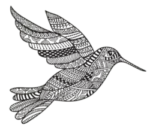(Or: How to Dine at Nature’s Most Exclusive Restaurants)
If the natural world had a fine dining scene, hummingbirds would be its most sophisticated connoisseurs. While some birds are content with simple seeds or insects, hummingbirds have evolved into nature’s master sommeliers of nectar, each species developing its own specialized approach to the sweet stuff.
Let’s start with some dining credentials that would impress any food critic:
- Can remember thousands of flower locations
- Visit up to 2,000 flowers per day
- Process nectar in 1/20th of a second
- Can taste sugar concentrations with extraordinary precision
- Track flowering schedules across vast territories
The Great Beak Diversity Show
Nature, in its infinite wisdom (and apparent sense of humour), has equipped different hummingbird species with beaks that look like they were designed by a committee of creative architects. Some are straight as arrows, others curved like scimitars, and a few look like they were bent by accident and just stayed that way.
The Specialty Diners
Different species have evolved unique approaches to their nectar consumption:
The Sword-billed Hummingbird:
- Sports a beak longer than its body
- Specializes in trumpet-shaped flowers
- Literally has to perch to groom itself because its beak is so long
- Probably wins all beak-measuring contests
The White-tipped Sicklebill:
- Curved beak perfectly matches heliconia flowers
- Masters of precision curved-beak feeding
- Looks perpetually surprised by its own beak
The Time Management Experts
These tiny dynamos approach their feeding schedule with military precision. They’ve mastered what scientists call “trap-lining” – following a precise route between flowers, timing their visits to coincide with nectar replenishment. It’s like having a mental Google Maps for restaurants, complete with real-time updates on when the kitchen restocks.
The Competition Game
When it comes to defending their food sources, hummingbirds display strategies ranging from sophisticated diplomacy to tiny aerial warfare:
Some notable approaches include:
- Territorial defence of prime feeding spots
- Time-sharing arrangements with other species
- Strategic alliances during migration
- The occasional dramatic mid-air chase sequence
The Specialist vs. Generalist Debate
While some species are extreme specialists, others take a more generalist approach to dining:
The Specialists:
- Evolved for specific flower types
- Master efficient nectar extraction
- Often have bizarre-looking beaks
- Committed to their dietary niche
The Generalists:
- Adapt to multiple flower types
- More flexible feeding strategies
- Better at dealing with environmental changes
- The omnivores of the hummingbird world
The Art of Efficient Dining
Perhaps most impressively, hummingbirds have mastered the art of efficient feeding. They can extract nectar while hovering, sometimes upside down, maintaining perfect stability while dining. It’s like trying to drink soup while doing gymnastics, except they make it look easy.
The Memory Masters
These tiny aviators maintain detailed mental maps of their feeding territories, remembering:
- Which flowers they’ve visited
- When each flower replenishes its nectar
- The sugar concentration of different flowers
- Which neighbours to avoid during breakfast
Conclusion: Nature’s Ultimate Dining Guide
The diverse feeding strategies of hummingbird species represent one of nature’s most impressive examples of specialized adaptation. Each species has essentially become a master chef in its own right, perfecting techniques for its particular culinary niche.
Remember: The next time you see a hummingbird at your feeder, you’re witnessing a creature that has turned nectar feeding into a high art form, complete with specialized equipment, precision timing, and attitude to spare.
Post Script: Some botanists suspect flowers evolved their current shapes just to keep up with hummingbird dining preferences. The hummingbirds aren’t confirming or denying this theory, but their smug expressions at feeding time tell us everything we need to know.


